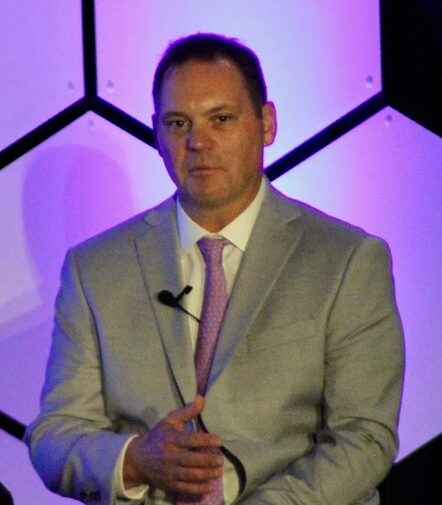Inspired by her grandparents, Tonah Fishinghawk-Chavez proves that caring for the community is an action, not just a word
Oil industry forecasts modest production from Bakken-Three Forks shale, spotlight on technology to spur development
North Dakota’s annual petroleum gathering welcomes new regulator, not regulations

Rough Rider Center in Watford City hosted North Dakota Petroleum Council’s annual two-day conference. (Photo credit/ Grace Fiori)
This week, the North Dakota Petroleum Council’s annual conference welcomed hundreds of local and national industry stakeholders to discuss the future of the country’s third-largest oil-producing state. Several presenters emphasized a desire to access underdeveloped reserves, local workforce development, and what many industry officials see as an increased onslaught of federal regulations.
Speculation abounds on the Bakken reaching maturity and unconventional oil peaking production. North Dakota Petroleum Council’s outgoing president Ron Ness said most operators estimate output in the coming years will remain nearly flat, with modest 1-2% increases. Devon Energy CEO Rick Muncrief echoed predictions that new well-building will continue for another decade, ushering in another 15 years of oil and gas extraction through emerging recovery processes.

On Wednesday, Sept. 18 more than 400 attendees welcomed the state’s new top oil regulator, Nathan Anderson. He took over for Lynn Helms, who held the position for almost 20 years. Whitney Stephenson, a North Dakota Petroleum Foundation board member, told Buffalo’s Fire she appreciates the industry experience Anderson brings to the role. The Minot native worked in oil and gas since 1989, most recently at Chevron.
Meanwhile, at this year’s meeting, “regulation has driven the conversation,” said attendee Lexee Dirk, environmental specialist for KLJ Engineering. Last year’s conference focused on research developments, she said.
The foundation’s board member Stephenson shared the observation. Both Stephenson and Dirk also noted that the upcoming national election and the state’s 2025 legislative session could further influence the industry’s future.
The North Dakota Petroleum Council’s regulatory affairs manager Eric Delzer documented 250 ways the current administration has “made it harder to produce oil and gas.” Delzer warned that consumers could shoulder increased operator costs for compliance. He also noted that it would cost millions of dollars to sue regulatory agencies but in the long run, so would staying compliant.
Chord Energy regulatory manager Dustin Anderson said, “working collaboratively (with federal agencies) is imperative as it’s ever been.”
The boom took hold of western North Dakota and the Fort Berthold Indian Reservation in 2008. By then, the hydraulic fracturing technique had advanced enough to be used profitably in the dense Bakken and Three Forks shale formations. As of February, the industry has extracted more than 5 billion barrels of oil in the state since 1951. North Dakota’s crude reserves and output now rank as the third largest in the United States, after those of Texas and New Mexico.
North Dakota Petroleum Council’s more than 550 member companies include 23 of the 25 largest producers in the Bakken. The trade association has been involved in the state’s oil and gas activity since a 1950s conventional oil boom.
During Wednesday’s discussion, Muncrief acknowledged that artificial intelligence has captured investors’ attention, shifting interest away from the oil and gas industry. Meanwhile, he believes the oil industry can remain relevant to investors by offering natural gas as the primary power source for the expected growth of data centers in North Dakota.
Brian Pickett, general manager of ExxonMobil’s unconventional oil production throughout the Americas, said obtaining enough water, power or carbon to make enhanced oil recovery cost-effective and widespread is a challenge. Industry officials have speculated about accessing Summit Carbon Solutions’ proposed storage facilities in Mercer and Oliver counties. It would trap carbon dioxide in underground pore space.
While the conference focused on operators’ needs and interests, KLJ’s environmental specialist Dirk told Buffalo’s Fire she was curious about “better-quality land management” in the Bakken-Three Forks oil-producing region. She attended to learn about other companies’ operations, identify potential partners and discuss how to foster a conversation between public and private partners.
The oil and gas industry has few mechanisms for feedback and relationship-building with tribal citizens, the tribal government, and federal agencies. “I think a lot of times there’s so many players now, it’s hard to get everyone’s opinion and hear all that needs to be said,” Dirk noted, adding that the most productive stakeholder conversations are often small and “table-driven.”
Grace Fiori
Former
Bakken Oil Boom, USGS, https://eros.usgs.gov/earthshots/bakken-oil-boom-north-dakota-usa
North Dakota State Profile, U.S. Energy Information Administration, https://www.eia.gov/state/
“Sixty Years of Boom and Bust” University of North Dakota, https://commons.und.edu/press-books/
North Dakota racing to meet the demands of data centers, the Forum of Fargo-Moorhead, Aug. 1, 2024, https://www.inforum.com/news/north-dakota/north-dakota-racing-to-meet-demands-of-data-centers
North Dakota oil regulator Lynn Helms to retire, North Dakota Monitor, Jan. 24, 2024, https://northdakotamonitor.com/briefs/north-dakota-oil-regulator-lynn-helms-to-retire/
Sell Our CO2 to Pump More Oil? It’s Likely, Says Iowa-based Carbon Capture Project.
DeSmog, April 4, 2024, https://www.desmog.com/2024/04/08/summit-carbon-solutions-midwest-express-co2-pipeline-eor-oil-north-dakota/
© Buffalo's Fire. All rights reserved.
This article is not included in our Story Share & Care selection.The content may only be reproduced with permission from the Indigenous Media Freedom Alliance. Please see our content sharing guidelines.
The billboard project is expanding to Oregon
Identification not yet made
Indigenous participation may be highest in the climate conference’s history
At an oak savannah near Eugene, Oregon, TEIP interns and elders carry forward a time-honored tradition, restoring meadow health and renewing relationship with the land
UTTC International Powwow attendees share their rules for a fun and considerate event







